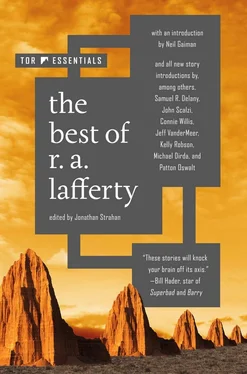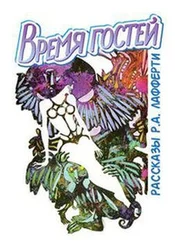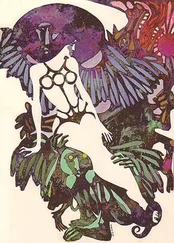“No, it isn’t,” said Robert Derby. “We can identify most of the strata of the chimney with known periods of the river and stream. I was above and below today. There is one stretch where the sandstone was not eroded at all, where it stands three hundred yards back from the shifted river and is overlaid with a hundred years of loam and sod. There are other sections where the stone is cut away variously. We can tell when most of the chimney was laid down, we can find its correspondences up to a few hundred years ago. But when were the top ten feet of it laid down? There were no correspondences anywhere to that. The centuries represented by the strata of the top of the chimney, people, those centuries haven’t happened yet.”
“And when was the dark capping rock on top of it all formed—?” Terrence began. “Ah, I’m out of my mind. It isn’t there. I’m demented.”
“No more than the rest of us,” said Steinleser. “I saw it too, I thought, today. And then I didn’t see it again.”
“The rock-writing, it’s like an old novel that I only half remember,” said Ethyl.
“Oh, that’s what it is, yes,” Magdalen murmured.
“But I don’t remember what happened to the girl in it.”
“ I remember what happened to her, Ethyl,” Magdalen said.
“Give us the third chapter, Howard,” Ethyl asked. “I want to see how it comes out.”
“First you should all have whiskey for those colds,” Anteros suggested humbly.
“But none of us have colds,” Ethyl objected.
“You take your own medicinal advice, Ethyl, and I’ll take mine,” Terrence said. “I will have whiskey. My cold is not rheum but fear-chill.”
They all had whiskey. They talked a while, and some of them dozed.
“It’s late, Howard,” Ethyl said after a while. “Let’s have the next chapter. Is it the last chapter? Then we’ll sleep. We have honest digging to do tomorrow.”
“Our third stone, our second stone of the day just past, is another and even later form of writing, and it has never been seen in stone before. It is Kiowa picture writing. The Kiowas did their out-turning spiral writing on buffalo skins dressed almost as fine as vellum. In its more sophisticated form (and this is a copy of that) it is quite late. The Kiowa picture writing probably did not arrive at its excellence until influenced by white artists.”
“How late, Steinleser?” Robert Derby asked.
“Not more than a hundred and fifty years old. But I have never seen it copied in stone before. It simply isn’t stone-styled. There’s a lot of things around here lately that I haven’t seen before.
“Well then, to the text, or should I say the pictography? ‘You fear the earth, you fear rough ground and rocks, you fear moister earth and rotting flesh, you fear the flesh itself, all flesh is rotting flesh. If you love not rotting flesh, you love not at all. You believe the bridge hanging in the sky, the bridge hung by tendrils and woody vines that diminish as they go up and up till they are no thicker than hairs. There is no sky-bridge, you cannot go up on it. Did you believe that the roots of love grow upside down? They come out of deep earth that is old flesh and brains and hearts and entrails, that is old buffalo bowels and snakes’ pizzles, that is black blood and rot and moaning underground. This is old and worn-out and bloody Time, and the roots of love grow out of its gore.’”
“You seem to give remarkably detailed translations of the simple spiral pictures, Steinleser, but I begin to get in the mood of it,” Terrence said.
“Ah, perhaps I cheat a little,” said Steinleser.
“You lie a lot,” Magdalen challenged.
“No I do not. There is some basis for every phrase I’ve used. It goes on: ‘I own twenty-two trade rifles. I own ponies. I own Mexico silver, eight-bit pieces. I am rich in all ways. I give all to you. I cry out with big voice like a bear full of mad-weed, like a bullfrog in love, like a stallion rearing against a puma. It is the earth that calls you. I am the earth, woolier than wolves and rougher than rocks. I am the bog earth that sucks you in. You cannot give, you cannot like, you cannot love, you think there is something else, you think there is a sky-bridge you may loiter on without crashing down. I am bristled-boar earth, there is no other. You will come to me in the morning. You will come to me easy and with grace. Or you will come to me reluctant and you be shattered in every bone and member of you. You be broken by our encounter. You be shattered as by a lightning bolt striking up from the earth. I am the red calf which is in the writings. I am the rotting red earth. Live in the morning or die in the morning, but remember that love in death is better than no love at all.’”
“Oh brother! Nobody gets that stuff from such kid pictures, Steinleser,” Robert Derby moaned.
“Ah well, that’s the end of the spiral picture. And a Kiowa spiral pictograph ends with either an in-sweep or an out-sweep line. This ends with an out-sweep, which means—”
“‘Continued on next rock,’ that’s what it means,” Terrence cried roughly.
“You won’t find the next rocks,” Magdalen said. “They’re hidden, and most of the time they’re not there yet, but they will go on and on. But for all that, you’ll read it in the rocks tomorrow morning. I want it to be over with. Oh, I don’t know what I want!”
“I believe I know what you want tonight, Magdalen,” Robert Derby said.
But he didn’t.
The talk trailed off, the fire burned down, they went to their sleeping sacks.
Then it was long jagged night, and the morning of the fourth day. But wait! In Nahuat-Tanoan legend, the world ends on the fourth morning. All the lives we lived or thought we lived had been but dreams of third night. The loin cloth that the sun wore on the fourth day’s journey was not so valuable as one has made out. It was worn for no more than an hour or so.
And, in fact, there was something terminal about fourth morning. Anteros had disappeared. Magdalen had disappeared. The chimney rock looked greatly diminished in its bulk (something had gone out of it) and much crazier in its broken height. The sun had come up a garish gray-orange color through fog. The signature-glyph of the first stone dominated the ambient. It was as if something were coming down from the chimney, a horrifying smoke; but it was only noisome morning fog.
No it wasn’t. There was something else coming down from the chimney, or from the hidden sky: pebbles, stones, indescribable bits of foul oozings, the less fastidious pieces of sky; a light, nightmare rain had begun to fall there; the chimney was apparently beginning to crumble.
“It’s the damnedest thing I ever heard about,” Robert Derby growled. “Do you think that Magdalen really went off with Anteros?” Derby was bitter and fumatory this morning and his face was badly clawed.
“Who is Magdalen? Who is Anteros?” Ethyl Burdock risked.
Terrence Burdock was hooting from high on the mound. “All come up,” he called. “Here is a find that will make it all worthwhile. We’ll have to photo and sketch and measure and record and witness. It’s the finest basalt head I’ve ever seen, man-sized, and I suspect that there’s a man-sized body attached to it. We’ll soon clean it and clear it. Gah! What a weird fellow he was!” But Howard Steinleser was studying a brightly colored something that he held in his two hands.
“What is it, Howard? What are you doing?” Derby demanded.
“Ah, I believe this is the next stone in the sequence. The writing is alphabetical but deformed—there is an element missing. I believe it is in modern English, and I will solve the deformity and see it true in a minute. The text of it seems to be—”
Читать дальше




![Рафаэль Лафферти - Дни, полные любви и смерти. Лучшее [сборник litres]](/books/385123/rafael-lafferti-dni-polnye-lyubvi-i-smerti-luchshe-thumb.webp)
![Рафаэль Лафферти - Лучшее [Сборник фантастических рассказов]](/books/401500/rafael-lafferti-luchshee-sbornik-fantasticheskih-ra-thumb.webp)